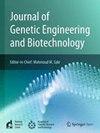A comprehensive in silico genome-wide identification and characterization of SQUAMOSA promoter binding protein (SBP) gene family in Musa acuminata
IF 2.8
Q3 Biochemistry, Genetics and Molecular Biology
Journal of Genetic Engineering and Biotechnology
Pub Date : 2025-01-23
DOI:10.1016/j.jgeb.2025.100461
引用次数: 0
Abstract
One of the largest and most significant transcription factor gene families in plants is the SQUAMOSA promoter binding protein (SBP) gene family and they perform critical regulatory roles in floral enhancement, fruit development, and stress resistance. The SBP protein family (also known as SPL) has not yet been thoroughly studied in the staple fruit crop, banana. A perennial monocot plant, banana is essential for ensuring food and nutrition security. This work detected 41 SBP genes in the banana species Musa acuminata. The MaSBPs were subsequently elucidated by investigating their gene structure, chromosomal position, RNA-Seq data, along with evolutionary connections with Arabidopsis and rice. Sequence alignment of MaSBPs revealed that all genes included a domain of two Zn finger motifs (CCCH and CCHC motifs) with an overlapping nuclear localization signal region. The conserved motifs sequence in the inferred MaSBP proteins were quite comparable. According to findings, the time frame of divergence for duplicated MaSBP gene pairs ranged from 42.39 to 109.11 million years and the dicot Arabidopsis and monocotyledonous plant banana diverged before the division of banana and monocot rice. Moreover, cis-acting element and GO annotation analysis exhibited possible biological activities of MaSBPs in flower development, phytohormone regulation, and stress tolerance. RNA-Seq expression profiling exhibited that genes MaSBP-3, MaSBP-20, MaSBP-37, MaSBP-40 were more expressed during floral and fruit development stage. The foundation for additional investigation of SBP protein sequences in other plants can be laid out by this study, which will shed light on some of their crucial biological functions.
针叶Musa SQUAMOSA启动子结合蛋白(SBP)基因家族的全基因组鉴定与特征分析
SQUAMOSA启动子结合蛋白(SBP)基因家族是植物中最大和最重要的转录因子家族之一,它们在花的增强、果实的发育和抗逆性中起着关键的调节作用。SBP蛋白家族(也称为SPL)在主要水果作物香蕉中的研究尚未深入。香蕉是一种多年生单子叶植物,对确保粮食和营养安全至关重要。本研究检测了香蕉品种Musa acuminata的41个SBP基因。随后,通过研究masbp的基因结构、染色体位置、RNA-Seq数据,以及与拟南芥和水稻的进化联系,对其进行了阐明。对masbp的序列比对发现,所有基因都包含两个Zn指基序(CCCH和CCHC基序)和一个重叠的核定位信号区。推断出的MaSBP蛋白的保守基序序列具有相当的可比性。结果表明,MaSBP重复基因对的分化时间范围为4239 ~ 109.11万年,双子叶拟南芥和单子叶植物香蕉早于香蕉和单子叶水稻的分化。此外,顺式作用元件和氧化石墨烯注释分析显示,masbp可能在花发育、植物激素调节和胁迫耐受方面具有生物学活性。RNA-Seq表达谱显示,MaSBP-3、MaSBP-20、MaSBP-37、MaSBP-40基因在花和果实发育阶段表达较多。该研究为进一步研究其他植物的SBP蛋白序列奠定了基础,揭示了SBP蛋白的一些重要生物学功能。
本文章由计算机程序翻译,如有差异,请以英文原文为准。
求助全文
约1分钟内获得全文
求助全文
来源期刊

Journal of Genetic Engineering and Biotechnology
Biochemistry, Genetics and Molecular Biology-Biotechnology
CiteScore
5.70
自引率
5.70%
发文量
159
审稿时长
16 weeks
期刊介绍:
Journal of genetic engineering and biotechnology is devoted to rapid publication of full-length research papers that leads to significant contribution in advancing knowledge in genetic engineering and biotechnology and provide novel perspectives in this research area. JGEB includes all major themes related to genetic engineering and recombinant DNA. The area of interest of JGEB includes but not restricted to: •Plant genetics •Animal genetics •Bacterial enzymes •Agricultural Biotechnology, •Biochemistry, •Biophysics, •Bioinformatics, •Environmental Biotechnology, •Industrial Biotechnology, •Microbial biotechnology, •Medical Biotechnology, •Bioenergy, Biosafety, •Biosecurity, •Bioethics, •GMOS, •Genomic, •Proteomic JGEB accepts
 求助内容:
求助内容: 应助结果提醒方式:
应助结果提醒方式:


